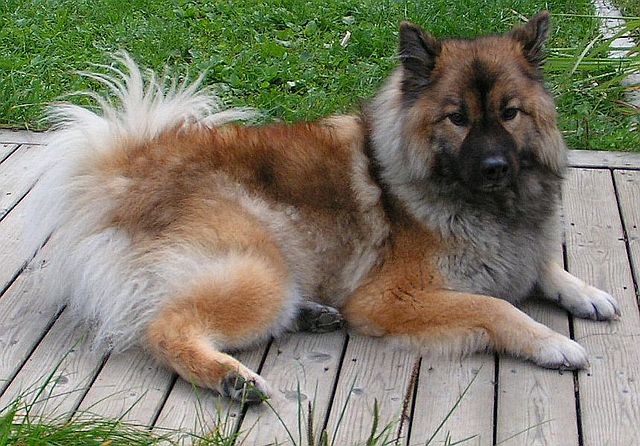The Eurasier is a relatively new breed, having only been created about 50 years ago in Germany. The Chow Chow, Keeshond and Samoyed all went into the creation of the breed, in order to develop dogs with excellent temperaments for family-living. The result was this medium-sized, double coated spitz breed with an even-tempered and loyal personality. In their home country, there are strict breeding practices to ensure that the breed is kept healthy and temperamentally sound. Health problems are minimal and the breed lives an average of 14 years.
In the home, the Eurasier should be kept as an indoor dog as he becomes quite bonded to his family. While he doesn’t necessarily have to be “in the thick of everything”, he does enjoy being in close proximity to his humans and joining them in activities when allowed. He gets along well with children, other dogs and cats although should be socialized while still a puppy for best results. With other dogs in particular, he is non-confrontational and not prone to fighting, even if another dog starts something. Gentle even with small pets, most don’t have a strong prey drive and are not prone to chasing. A Eurasier with the proper temperament should not be easy to provoke, which means this is not a guard dog. He may or may not be a suitable watchdog as he doesn’t tend to bark very often, although will bark or growl when he believes it is necessary. With strangers, he tends to be aloof until he gets to know the person.
The Eurasier does need daily exercise in the form of walks and/or vigorous play with other well-socialized dogs. A day swimming and running on the beach is another enjoyable activity, as is an off-leash romp or hike (once trained). As long as he is given fun activities daily he is calm and easy to handle once he comes back inside – but this is an active breed while outdoors and not a lazy bum, meaning that he needs an owner that can handle his outside exuberance!
The Eurasier also needs regular grooming, particularly a good brushing at least once a week. During shedding seasons (twice a year), grooming frequency will become once a day. The coat (which comes in a multitude of colors) is his crown glory and does require care to stay nice. It’s also worth noting that Eurasiers which have been spayed or neutered will develop coats that are harder to care for, which is something to keep in mind. Baths can be somewhat infrequent as the coat doesn’t tend to get too smelly, unless the owner desires him to stay extra clean.
Eurasiers are intelligent, and although they were bred to be companion animals and not working dogs, most are generally easy to train. Although they don’t have quite the same drive as breeds which were created to work all day, they have an almost endless desire to please their owners! With proper motivation they can learn and enjoy activities such as obedience or agility. This breed is also a natural therapy dog and with a bit of basic training, can excel in the therapy route! Use lots of consistency and encouragement when training a Eurasier, they can be sensitive.
The Eurasier should never be aggressive or timid, and instead should always display a confident (yet relaxed) demeanor. This said, the sensitive nature of the breed means that they don’t do well in homes with lots of shouting or fighting. They also don’t do well in homes in which the owner is often gone as many suffer from separation anxiety. Even those left home alone in the backyard can be prone to escaping due to distress!
In the United States, one must be prepared to wait for a Eurasier once they have decided this is the breed for them – it is still a rare breed! The wait is worth it, however. Eurasiers are adaptable to many different living situations and can do just as well in an apartment as on a sprawling ranch. Indoors they are calm, well-behaved and affectionate. Even in small homes, they don’t tend to be destructive and will even watch their steps to avoid toppling over belongings (young puppies excluded, of course). They are independent enough to keep them from being overly needy, although are always ready to play and spend time with their families.

Photo CC BY-SA 3.0
